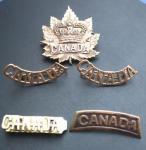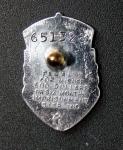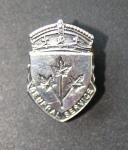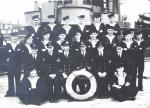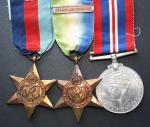-
Posts
13,225 -
Joined
-
Last visited
-
Days Won
22
Content Type
Profiles
Forums
Blogs
Gallery
Events
Store
Everything posted by Mervyn Mitton
-

female royal military service
Mervyn Mitton replied to aubagne98's topic in Great Britain: Research, Documentation & History
Would the Princess Royal - Princess Anne count ? She is a Vice Admiral and - I think head of the Naval Women's Services. Like Paul I can't think of any other candidate. Mind you - it wouldn't hurt for a few of them to volunteer - there seem to be 'hundreds' of them in strange hats............. -

home spiked helmet
Mervyn Mitton replied to blueman's topic in Great Britain: Militaria: Badges, Uniforms & Equipment
For this condition - and a known owner - I don't think this is at all unreasonable. Look forward to seeing more pictures and details. Mervyn -

home spiked helmet
Mervyn Mitton replied to blueman's topic in Great Britain: Militaria: Badges, Uniforms & Equipment
Mike - I wouldn't regard that as expensive these days. They are an investment and will certainly rise in price in the future. Blueman - you have a fine officer's helmet with all of it's fittings - including the tin. We will look forward to seeing full pictures when it arrives. Tell us what you paid - or, send me an IM. Mervyn -
INTRODUCTION The Battle of Isandlawana in 1879 was the worst defeat inflicted on Britain in a Colonial War. For that reason alone, this old newspaper report is a valuable document. However, it is far more then that - the details given make it a valuable historical document, and it for this reason that I am posting it on the BLOG section. This will allow it to be read by nonMembers who can access it from Google. Basically it is the story of Mr. W.M. Adams - who died in December 1916 at the age of 96. The report of his death and a short history of his life appeared in the Pietermaritzburg (Capital of Natal) "Natal Witness" of Dec.8th 1916. The story was written by a close friend of his and is therefore accurate - making it a rare historical document from an earlier time. Mr. Adams was born in England in 1820 - 7 months after the death of King George 3rd. He came to Durban at at 22 years of age in 1842 - which makes him one of Natal's earliest pioneers ------------------------------------------------------http://gmic.co.uk/uploads/monthly_08_2012/blogentry-6209-0-38958400-1344782858.jpgclick to enlarge--------------------------------------- ..................................................................THE LATE MR.W.M. ADAMS........................................................ .....................................REMINISCENCES OF ISANDLAWANA................................ Mr. William Adams Snr., whose photograph appears in this issue ,so well known in the Northern Districts as one of the old pioneers, passed away on November 28th at the ripe age of 96. I had known him intimately for some years and it is difficult to believe that the genial old gentleman, who strongly held his own for half a century, and who so succesfully faced the hardships and perils of those early days, has at last relinquisheed the struggle and answered the call to his long rest. Mr. Adams landed at the Port of Durban in 1842, arriving in the 'King William' which accomplished the journey from England in 3 1/2 months. He was then 22 years of age. Durban hardly existed in those days and ' McDonald's Hotel ' where Mr. Adams took refuge was built of sods ! The young man became a trader and hunter and in the course of his wanderings for 30 years he visited almost every part of South Africa, at one time venturing as far North as the Zambesi. .....................................................A HUNTER'S PARADISE...................................... Natal was then a hunters paradise and lions and elephants often fell to Mr. Adam's gun . Once an elephant attacked him with such suddeness that he could only fall flat on the ground to avoid the charge. The animal's feet actually missed by inches, but luckily the impetus carried the elephant sufficiently ahead to enable Mr. Adams to recover his gun and as the animal returned to the attack he shot it dead. Another time, Mr. Adams was being carried across the Tugela River by a native and just as they reached the bank, the unfortunate native was seized by a crocodile and killed - Mr. Adams barely reached the bank. In 1853 he married Maria Elizabeth Strydom. It was a happy union. She cheerfully with him the perils and the privations of those early days accompanying him in his journeys proving herself a true helpmate and a good mother to his children. She has survived him and is now 82 years of age. Lattererly they have lived in a small cottage near the Helpmekaar Magistracy, with one of their Grandsaughters as a companion. The home was not an elaborate one but it was spotlessly clean, and the old couple seemed as contented with one another's society as they must have been when first married. Their honeymoon took the novel form of a hunting trip to Zululand, in which they had an exciting experience. One day a couple of lions stalked out of the shrubs ahead and barred the path. Their manes bristled and they showed every indication of an attack upon the frightened oxen. Mr. Adams and two of his natives rushed ahead, covering the lions with their guns - and shot them dead. The young trader was well acquainted with the famous Dick King, and he often related the story of how one winter's night he and Mr. King rode from Durban to Botha's Hill, the latter told him of his stirring ride to the Cape'for reinforcements. It was a wonderful story and Mr. Adams always spoke of Dick King as a ' fine fellow'. One of Mr. Adam's earliest ventures was the establishment of a trading station at what is now Bond's Drift. Here he met the veteran Dutch pioneer, Piet Hogg , and they had an exciting experience with the warlike Zulus. It was just about the time that Cetywayo and Umbulazi were disputing for the headship of the Zulu Nation. One day an armed party of Zulus swept down upon the traders , carried off the oxen and left the owners and their families stranded. The plucky traders went off in hot pursuit, caught up the marauders and at great personal risk demanded the return of the oxen. They were succesful and wisely decided to immediately trek South until matters became more settled. A year or two later found Mr. Adams and his family settled about four miles from Rorke's Drift. The country was then a native location, there being only four white families in the district. One of those was Mr. Rorke, whose name will live forever in history, on account of the famous drift named after him. When Cetywayo finally became King it was apparent to Mr. Adams - living as he did on the border - that serious trouble was brewing. He joined the Border Mounted Rifles, and at the outbreak of war held the rank of Quarter Master Sergeant. .........................................................http://gmic.co.uk/uploads/monthly_08_2012/blogentry-6209-0-38958400-1344782858.jpgclick to enlarge........................................... There was no adventure which he told so freely as those which befell him in the Zulu War. He and his son were present at the fatal battle of Isandlawana. He was one of the first to realise the danger on that disastrous day. The small British force was scattered, and as the mighty Zulu Impi, half moon in shape sprang out of their hidden dongas and began advancing on to the doomed band, Mr Adams pleaded with the Imperial Officers to concentrate and form a laager. His advice was unheeded. He fired to the last and as the 'horns' were closing round, he and others , seeing that all was lost, dashed through the opening and made for Fugitives Drift. He was pusued most of the way and just managed to reach the Buffalo River in safety. A few days later he had the joy of meeting his son whom he had given up as lost and who had escaped at a drift lower down. ' How did you manage to escape ' I more then once asked him and the old gentleman - with a twinkle in his eye - woulkd reply ' Funk and a good horse'. Mr. Adams also took part in the first Boer War, this time in the Transport Service. At the close he returned to Rorke's Drift, where he remained until the outbreak of the second Boer War. He was taken prisoner by the Boers, sent to Pretoria, but subsequently released and he ultimately arrived via Delgoa Bay. Later he was joined by his wife who though 60 years of age, evaded the Boers and in a small waggon crossed Zululand and entered Natal through Bond's Drift. He was fond of telling of the changes that had taken place in Durban since he first saw it. Then it was a collection od sand dunes and thick bush and these had now given place to an up-to-date and prosperous seaport , with trams, macadamised streets and all those things which mark the advance of a 20th. Century civilisation. He returned to Rorke's Drift, but in 1910 after a residence there of 54 years he sold out and purchased a small home at Helpmekaar, where the old couple spent their declining years. He took a keen interest in the present European War and enjoyed good health to the last. We all hoped and believed he would reach his Century. He was born 7 months after the death of George 3rd. of England and so lived during the reign of 5 Sovereigns. On the morning of the 24th November he looked ill. Mrs Adams sent for the Doctor who pronounced the illness to be of a serious nature. He never rallied but passed peacefully on the 28th ultimoo and was buried in Helpmekaar the following day. In addition to his widow, he leaves 6 children (living) , 36 grand children and 10 great granchildren. I hoped you enjoyed reading of this early pioneer - of people such as this the British Empire was set-up.
-

Repairing a Broken Scabbard
Mervyn Mitton replied to Brian Wolfe's topic in Preservation & Restoration of Military Artifacts
I think when it's been polished down, that you will hardly see the repair. I've always said - you are a true craftsman. Mervyn -

home spiked helmet
Mervyn Mitton replied to blueman's topic in Great Britain: Militaria: Badges, Uniforms & Equipment
Blueman - another good find. However, you have posted the pictures with no mention of the labels or, other details. Please add these for the interest of Members. Mervyn -
Zorg - an interesting medal. Until you can get some further research I would say that there is the possibility of the suspender having been added. Just doesn't look right - at least to me. The other problem is the clasp - the style and naming could well be for an earlier issue. I don't think the Duty mark is the head of King George 3rd. He died in 1820. It could well be for George 4th (1820-1830) or, for King William 4th. (1830-37) Both of their Marks faced to the right. Queen Victoria assumed the throne in 1837 - so the time difference is 23 years - even if it was issued in the last year of William 4th. - and the medal is for 1860. Could well be worth contacting the Army Museum in London to see what they have on record. Perhaps a Member here will be able to give further info. ?
-

HOW WE USED TO SHAVE....
Mervyn Mitton replied to Mervyn Mitton's topic in Non Military Collectibles & Antiques
You must have a very steady hand - I doubt I could even lift the big one................ -
--------------------------------------------------http://gmic.co.uk/uploads/monthly_08_2012/post-6209-0-59894800-1344606774.jpgclick to enlarge----------------------------------------------------- I had intended to add this on Wednesday - however, most of S.A. was covered in snow and computers went down without warning. I thought this only happened in Canada ? I thought these were interesting - three different types of shoulder titles and a Victorian plate, which I think must have been for the slouch hat ? See what you think and thankyou Mike for the cross ref. - you do wonder why so many variations were made
-
------------------------------------------------------http://gmic.co.uk/uploads/monthly_08_2012/post-6209-0-77022700-1344350079.jpgclick to enlarge----------------------------------------------- Amongst a small collection of badges, I found the Canadian ones shown here. This one appears to be a lapel - perhaps for servicemen on leave or, off duty. The reverse shows a high penalty for misuse. It is silver. Comments on all of them will be appreciated. Mervyn
-
I found this to be an interesting group with it's attached photos. Also, it makes a change from the bigger ships we usually see. When we entered the War in 1939 , ship of all classes were short - particularly anti-mine vessels. One of the quickest and easiest ways to provide them, was to take over fishing trawlers. The officers were usually Royal Naval Volunteer Reserve and they quickly became proficient. This was just as well as German planes would fly over selected ports and estuaries and drop mines. Casualties were high - I have left the papers which covered the two trawlers which Lt.J.L. Mathews RNVR served on as Commander. http://gmic.co.uk/uploads/monthly_08_2012/post-6209-0-99200200-1343923553.jpgclick to enlarge His entitlement was 39/45 Star, Atlantic Star and the War Medal. Particularly interesting is his Atlantic Star with France and Germany Bar. Serving in Home Waters the opportunity to be awarded a lot of medals was not there - however, those serving at the time of 'D ' Day in the North Sea - The Channel or, the Bay of Biscay received this Bar. The value of the Medal increases quite considerably.



